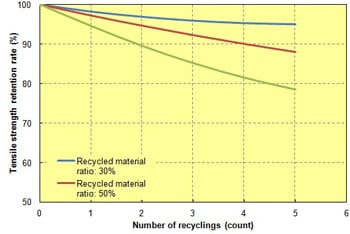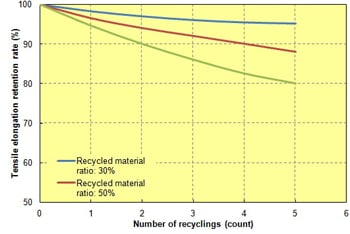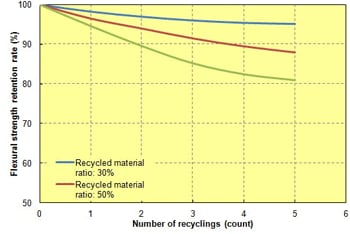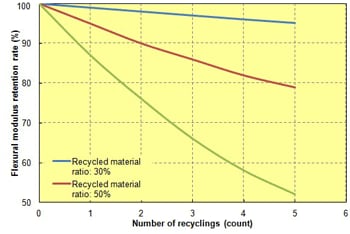- HOME
- Technical Information
- TORELINA™ PPS Resin
- Injection Molding
- Recycling
Recycling
To recycle TORELINA™ sprue, runner, and so on, pay careful attention to the fact that they will be affected by thermal history and the mechanical properties and the moldability will change with damage to reinforcement due to the shear force to which the reinforcement is subjected in the molding process. In general, the mechanical strength will decrease as a result of recycling, but the electrical properties, sliding properties, flammability, chemical resistance, and so on will not change greatly. Property changes in A504X90 as a result of recycling are shown in Figs. 5.1 to 5.4. The conditions are as follows:
- Injection molding conditions:
Cylinder temperature of 320℃, mold temperature of 130℃ (predrying: 130℃ × 3h) - Recycling method:
Crush molded products with a crusher to prepare recycled material. Blend recycled material with virgin material uniformly at a ratio of 30%, 50%, and 100% for use in injection molding. - Number of recyclings:
1 to 5
If the recycled material ratio is within 30%, at least 90% of the properties of the virgin material will be retained. When using recycled material, manage the recycled material itself strictly, and carefully consider the required quality of the product before deciding on the recycled material ratio. TORELINA™ molded products are hard, so crushing them may cause the cutter blades to wear, causing fine metallic powder to mix with the recycled material. Keep this in mind, particularly when using recycled material for small-size electrical parts. In addition, if recycled material is used, this may influence the moldability, including the fluidity and solidification properties.
For reference, for UL-certified materials, UL746D contains the following provisions: "Parts shall not be molded from material that contains more than 25-percent thermoplastic regrind by weight, that has been dry blended by the molder with the same grade of virgin material, unless the results of a separate investigation indicate acceptable performance for the specific part."

Fig. 5.1 Recycled material properties/tensile strength (A504X90)
Fig. 5.2 Recycled material properties/tensile elongation (A504X90)

Fig. 5.3 Recycled material properties/flexural strength (A504X90)
Fig. 5.4 Recycled material properties/flexural modulus (A504X90)